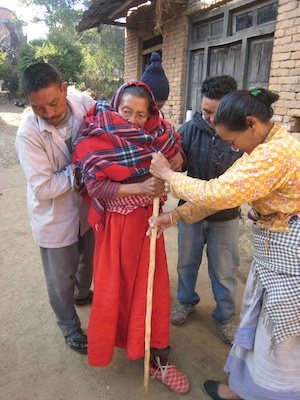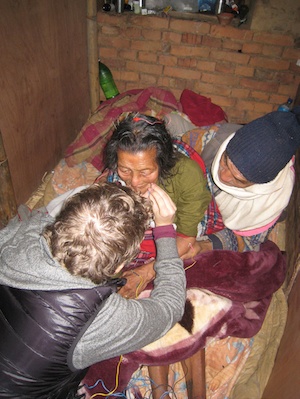Stephanie Grant MAcOM LAc
December 2012
OVERVIEW
 81-year-old female presents with complete left-sided hemiplegia following ischemic stroke 2 months ago. Over the course of 7 weeks of acupuncture treatment, the patient regained limited voluntary dorsi and plantar flexion of her left foot, flexion and extension of her knee and elbow, and increased sensation in her left arm. The patient also developed a cough due to fluid in the lower left lobe of her lungs 5 weeks after the stroke, a common concern for patients with limited mobility living in the cold and damp houses of Nepal. The cough was successfully treated with Chinese herbs.
81-year-old female presents with complete left-sided hemiplegia following ischemic stroke 2 months ago. Over the course of 7 weeks of acupuncture treatment, the patient regained limited voluntary dorsi and plantar flexion of her left foot, flexion and extension of her knee and elbow, and increased sensation in her left arm. The patient also developed a cough due to fluid in the lower left lobe of her lungs 5 weeks after the stroke, a common concern for patients with limited mobility living in the cold and damp houses of Nepal. The cough was successfully treated with Chinese herbs.
SUBJECTIVE
81-year-old female presents with hemiplegia of the left side as sequela of ischemic stroke. 1 week prior to initial assessment, the patient awoke from resting and was unable to move, her left arm and leg were numb, she could not talk nor open her left eye, and could not sit up by herself. Her family immediately transported her to the hospital where she was admitted for 4 days. At the time of discharge from the hospital, she had regained some limited speech and could open her left eyelid.
Initial exam is 7 days after the stroke. She reports inability to move either left limb and has limited movement of the left side of her face. She describes her entire left side as feeling heavy and numb. The patient tends to feel hot, particularly in the evening, and experiences night sweats. She has no appetite, a slight thirst for cold drinks, blurry vision, dizziness and complains of a dry throat.
Medications upon initial evaluation include Atorvastatin (Lipolow-10) 10mg QD, Aspirin 75mg QD and Ranitidine (R-Loc) 150mg QD.
OBJECTIVE
Patient appears thin, weak and is bed-ridden at time of initial assessment. She is unable to sit upright without assistance. There is no atrophy of muscles on the left side. Her skin is dry to touch, and she exhibits some degree of hearing loss normal for her age.
The patient demonstrates no voluntary motor control of her left limbs. Her left forearm and hand is mostly contracted and cannot be extended with gentle force. She can slightly raise her left shoulder and can easily move her left arm with her right. Her left hip joint is slightly mobile, and there is no apparent contracture of her left thigh and leg. There is no notable temperature difference side-to-side on palpation. Both sides are warm when covered by blankets.
DTR’s all measure +2 on the right and +3 on the left. Dull sensation is intact and equal on both arms and legs. Sharp touch is equal side-to-side on dermatomes C6, C8 and L5, but slightly decreased on dermatomes C7 and S1 on the left side at the distal tips.
The lateral corner of the patient’s left eyelid droops slightly compared to the right, but she can raise and close both eyelids. The patient’s left side of the mouth droops, and she cannot smile equally on both sides. She can puff out both cheecks. She exhibits slight aphasia and hardly responds to questions when asked. There is some moisture gathering at the lateral corners of her mouth and left eye.
Pulse is thin and taught across all positions, floating and rapid.
Tongue is thin and red with a thick, dry, yellow-grey coat.

ASSESSMENT
DX: Left-sided paralysis as sequela of an ischemic stroke
TCM DX: Sequela of wind-stroke with wind-phlegm obstructing the channels and collaterals and underlying yin deficiency with empty heat
PROGNOSIS: Guarded as the patient is 81 years old and suffered an ischemic stroke. Factors in her favor include daily acupuncture treatments, continued progress in voluntary movement of her left foot over the first 30 treatments, and dedication from her family in assisting her recovery with constant care and physical therapy exercises at home
INITIAL PLAN
Acupuncture treatments 6 days per week with regular reassessments at 3-week intervals.
Focus acupuncture on clearing wind-phlegm from the channels and collaterals with continuous monitoring of vital signs for evidence of hypertension or pneumonia, both of which pose a greater risk to the patient’s life than post-stroke sequela.
Typical points include: Jiao’s motor region right side upper limb ~ lower limb, left LR3 ~ ST36, GB41 ~ GB34, Ba Feng, GB39, SP6, LI4~LI11, Ba Xie, DU26, CV24, ST4, ST3, SJ23, Yu Yao (~ indicates e-stim between points at 5Hz continuous for 5-8min). Total treatment time is limited to 10-15 minutes, as the patient is easily fatigued by acupuncture.
Counsel patient about twice-daily exercises to flex and extend left toes, foot, leg, fingers, hand and arm. Encourage routine exercises in spite of lack of joint movement. Encourage patient to go outside daily to sit upright in the sunshine and take short walks with the assitance of her family. Teach the patient’s family to massage the patient’s left limbs with mustard oil, gently moving the arm and forearm to full extension to reduce contracture
CONTINUING TREATMENT PLAN
Subjective
4 weeks into treatment, the patient develops a cough with inability to expectorate. She denies fever or chills, sore throat, headache, or tension in her neck and upper back. The little sputum she expectorates is thick, sticky and yellow-grey. She is living on the ground level of a brick and mortar house with hard pack dirt floors. She spends most of her time on a makeshift bed, consisting of a pallet of 3 blankets over top of a plastic tarp to protect her from the cold-damp weather of early winter in Nepal. The patient’s family takes her outside daily in the sun to do exercises and rest in the warmth for a few hours each day. Otherwise the patient spends most of her time lying on her back in this room without electricity or heat.
Objective
Chest auscultation finds high-pitched crackles in the upper lobes, and percussion produces increased resonance in the lower left lobe of the lung. Blood pressure is 160/70mmHg, pulse rate is 68bpm, and pulse oxygen measures 92%. Oral temperature is 98.3 deg F.
Assessment
DX: Possible consolidation of the lower left lobe of the lungs, likely due to immobility and secondary pulmonary hypertension. The exact cause and severity of the fluid in the lower left lobe of the lungs cannot be determined without additional testing.
TCM DX: Cough due to phlegm-heat in the lung PROGNOSIS: Good as the condition is caught early and is monitored with auscultation of breath sounds at every acupuncture treatment. The patient’s living environment will not change, however, and will be a continuous challenge throughout her recovery.
Updated Plan

Points added to the initial acupuncture prescription include LU5 and ST40.
Internal formula administered is Qing Qi Hua Tan Wan 8 pills TID for 3 weeks. The patient is also immediately referred to her allopathic physician for uncontrolled hypertension and is prescribed Amlodipine 5mg QD.
Counsel the patient and her family on adequate water intake and proper diet to reduce phlegm and hypertension.
OUTCOME
After 36 treatments, the patient exhibited major changes in the motion of her left foot, and marked improvement in auscultation and percussion of her lungs. She described her limbs as feeling “lighter.” At this time, she was able to walk slowly with the assistance of a walking stick and 2 other people, and she could stand with a walking stick and the support of 1 other person. Her shen/mood became much brighter as indicated by her laughter and smiling during treatments. She began to look forward to walking with her goats in the fields again.
The patient’s left knee could actively flex and extend through 90 degrees range-of-motion. She could plantar and dorsiflex her ankle 5 degrees and dorsiflex her great toe voluntarily. The other toes could dorsiflex with needle stimulation. She could flex her left elbow 10 degrees and extend 5 degrees, but she continued to be unable to move her left fingers and wrist. Contracture of the left forearm significantly reduced with regular home massages, and the patient reported pain and tingling in her left arm after massage and acupuncture. Sharp/dull touch became equal side-to-side, while DTR’s on the left were still at +3. The patient was also able to sit upright on her own for long periods of time without assistance, and her speech became much clearer and easier to understand.
The patient described her lungs as feeling less congested, and she found it easy to expectorate phlegm. Her lungs sounded markedly clearer on auscultation. High-pitched crackles remained, but there was no longer resonance on percussion of the lower left lobe. However, the lower right lobe exhibited some slight resonance with percussion. Her blood pressure reduced to 130/72mmHg, pulse rate was 72bpm and pulse oxygen increased to 96%.
Her tongue was thin and slightly red with a clear dry coat. Her pulse was slightly rapid, thin and taught across all positions.
CONTINUED TREATMENT
The patient will need continued daily acupuncture treatments with emphasis on clearing wind-phlegm from the channels and collaterals. The patient’s blood pressure and lungs should be routinely monitored. Her physical abilities should be objectively measured every 3 weeks with emphasis on active range-of-motion, DTR’s, sharp/dull touch and facial muscle testing.
With further resolution of the consolidation in her lungs, herbal treatment focus may shift from clearing phlegm-heat from the lungs to nourishing the patient’s yin and clearing empty heat. The patient should be referred to allopathic care for more testing, diagnosis and stronger medications if the consolidation in her lungs becomes more significant, spreads to more than one lobe, if she develops a fever or if her blood pressure increases above 140/90mmHg.
The patient has responded well thus far to regular acupuncture and herbal treatments, and continued improvement is expected.
CONCLUSION
Routine acupuncture treatments are an effective method for regaining mobility post-stroke, particularly when used in conjunction with supportive home care and regular physical exercises.
In providing daily treatments, the acupuncture physician is in a unique position to serve as a primary care provider, monitoring for other physical ailments which may develop quickly and pose a significant threat to the patient’s recovery. As demonstrated in this case study, routine auscultation of the lungs led to early diagnosis and treatment of fluid consolidation in this patient’s lungs.











